This is the complete guide to customer experience (CX) in ecommerce.
If you’ve ever wondered:
“How do I increase my sales and attract loyal customers?”
…you might have thought about vouchers, email marketing or social media campaigns.
In the end, those must be the quickest ways to grow your business, right?
Wrong!
The secret sauce of a highly successful online shop has little to do with any marketing tactic.
Instead, it is a relentless focus on delivering a great customer experience.
A recent survey among organisations worldwide revealed that over 88% of business owners view a focus on CX as relevant to compete in their market.
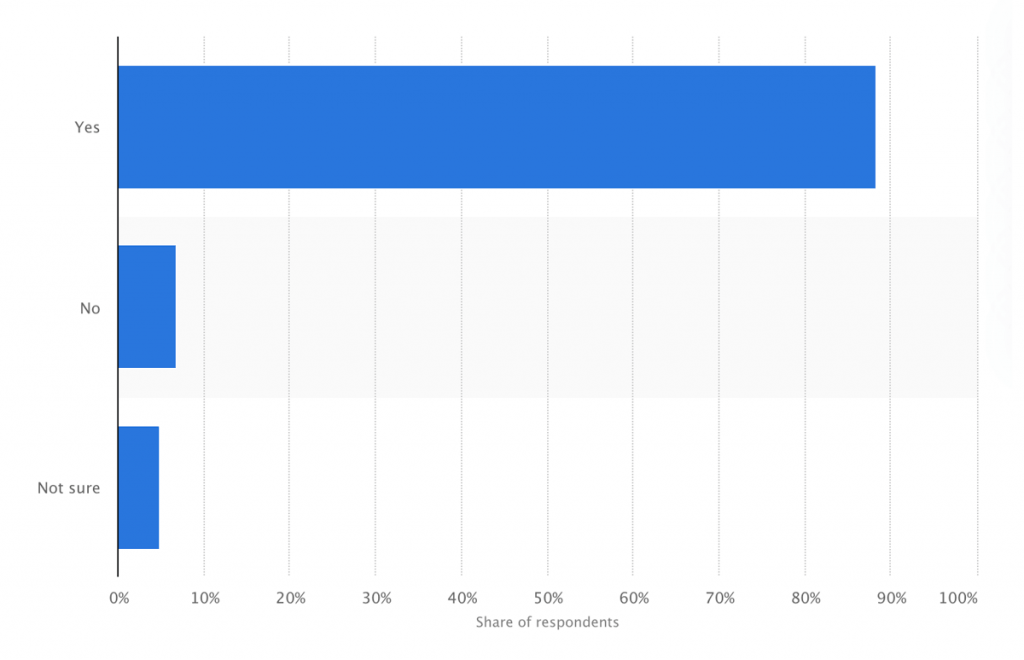
So if you want to make sure that your online shop’s customer experience is the best it can be, you should get a ton of value from today’s guide.
In this complete guide, you’ll learn:
- What customer experience is
- Why it is important
- What makes a good customer experience
- How to measure customer experience
- How to improve your customer experience
- Examples of great customer experiences
Let’s get started.
Definition: What is Ecommerce Customer Experience?
In ecommerce, customer experience (CX) is a customer’s perception of their experience before, during and after visiting your online store.
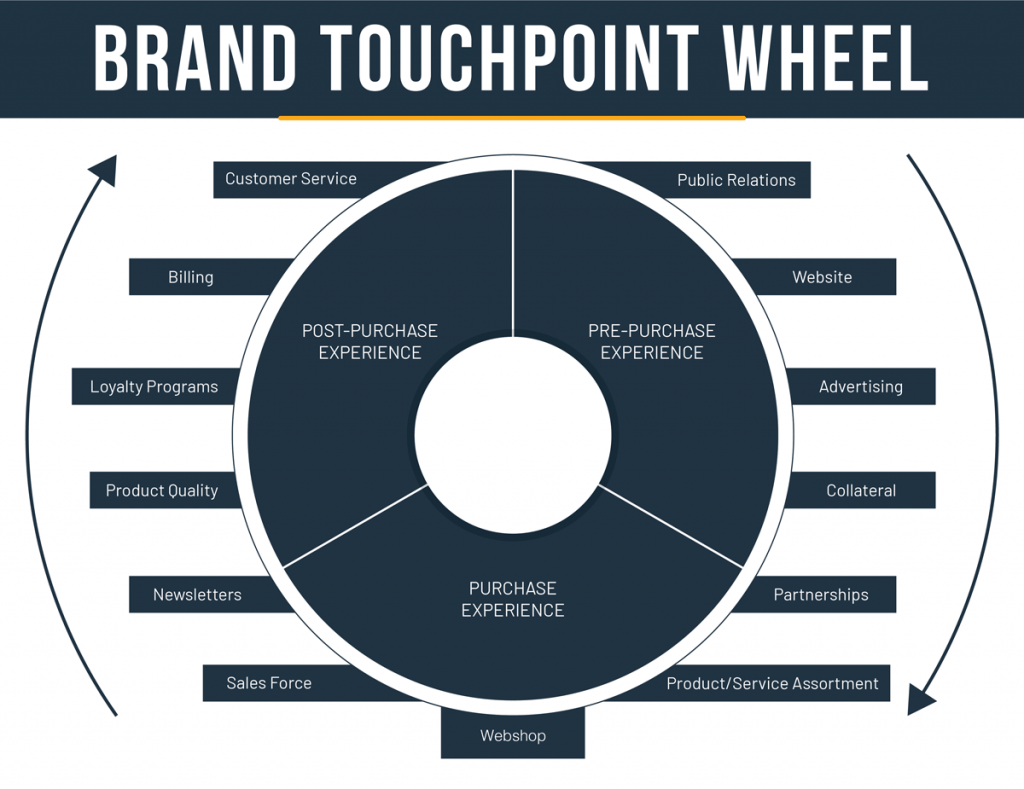
In fact, CX is the result of every interaction and touchpoint a customer has with your business.
From seeing your Facebook ads to building a cart in your online store: each part of the customer journey has an impact on the overall shopping experience.

The customer experience is made of three main components:
- Service Experience: The support you offer to your customers via different communication channels, e.g., phone, email, chatbots, etc.
- Product Experience: The ease of use, quality and effectiveness of your product. Note that in ecommerce, your online shop is often part of the product experience.
- Brand Experience: Your brand’s touchpoints with your customers. This includes the marketing, the design and the feelings your brand creates for your customers.
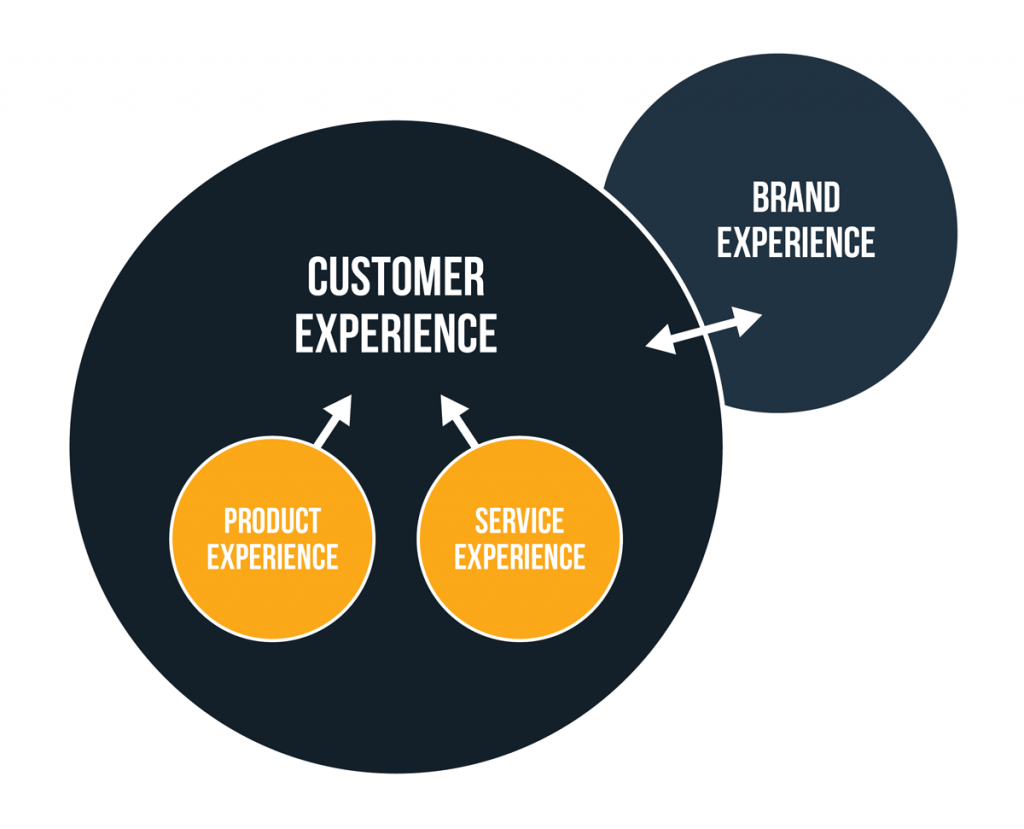
While the three areas are quite distinct, there are no hard lines between them. In fact, they’re all part of the wider customer journey.
That said: the brand experience and customer experience are seen as parallel items that influence each other in this model.
That’s because the shopping experience forms part of the brand image in the mind of a customer.
In other words: if people link your online shop with a positive experience, your brand’s reputation will improve. And if people like your brand, chances are that they’ll also enjoy their shopping experience with you.
Why is Customer Experience so Important?
So by now, you might wonder:
“Why is a focus on CX so important?”
Well, think about the most customer-centric company that comes to your mind.
Chances are that your thoughts involve in one way or another Amazon.
And that’s for a good reason. Their shopping experience is one of the best you’ll find on the world wide web.
Amazon even leads the American Customer Satisfaction Index (ACSI) in the category Internet Retail:
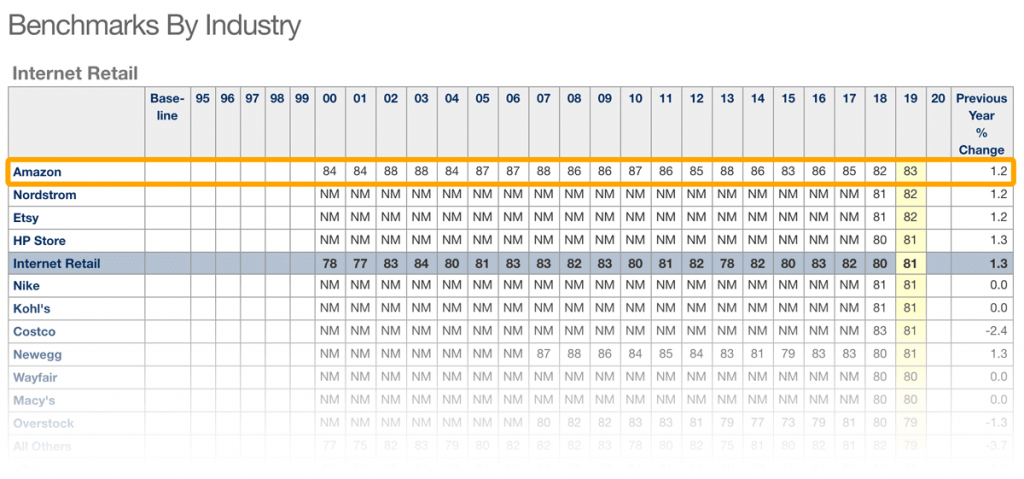
How do they do that?
Take a look at their job portal:
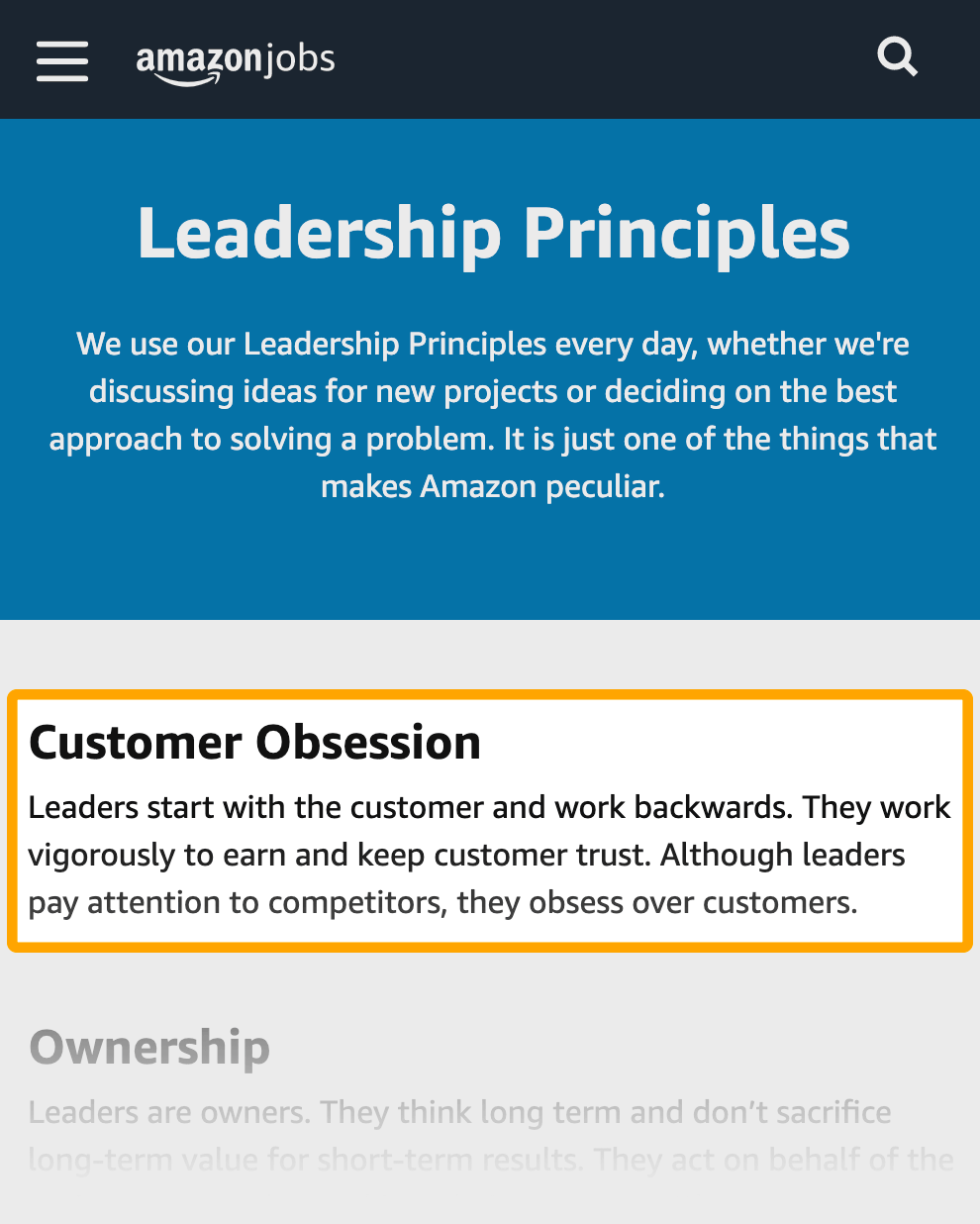
They have a total of 14 leadership principles.
Yet, the very first principle they list is “Customer Obsession”.
And that’s no coincidence.
Amazon owes its success to a relentless focus on creating value for its customers.
Thus, they want to hire people who are super focused on a good customer experience.
Here’s a quote from Amazon’s shareholder letter from 1997:
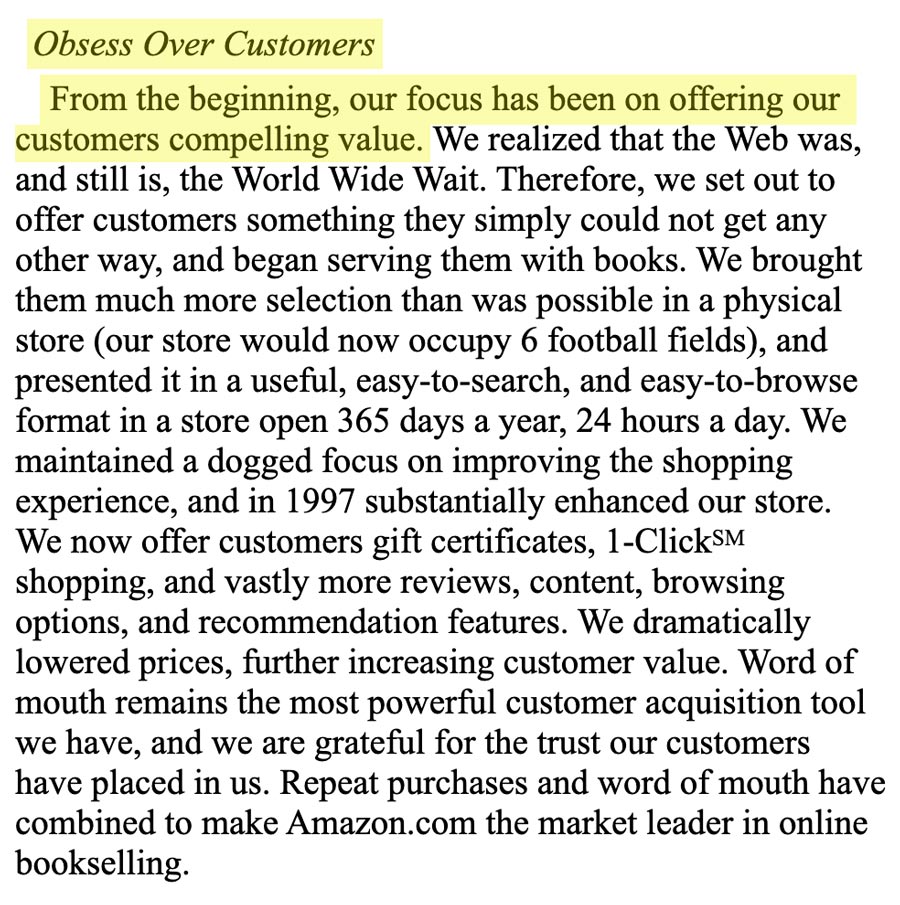
Fast forward 20+ years and they’ve become one of the most successful companies in the world.
You see, the reason why a focus on customer experience is so important is that it drives long-term benefits for your business, including:
- Greater customer loyalty
- Higher customer satisfaction
- Repeat purchases at higher price points
- Positive word of mouth
- The ability to build a strong ecommerce brand
Want proof?
A recent study from Walker’s found that 86% of buyers are willing to pay more for a better CX.
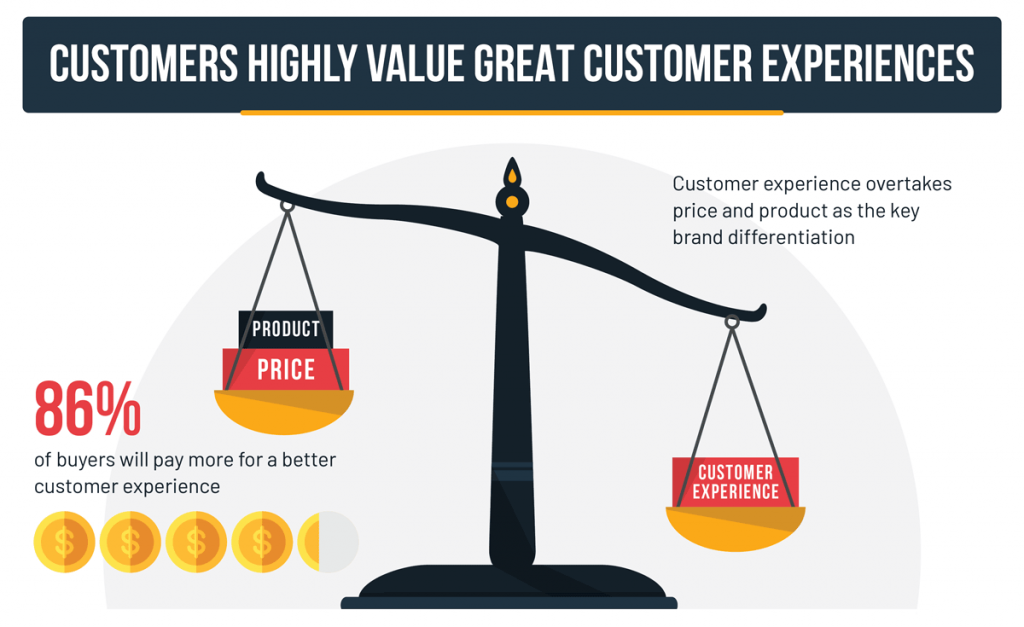
And a report by Dimension Data found that 92% of companies who focus on CX saw an increase in customer loyalty, and 84% saw an uplift in their revenue numbers.

The bottom line? If you want to build an online business that turns visitors into loyal fans, focus on creating the best possible customer experience for them.
Speaking of which…
What Makes a Good Customer Experience?
We’ll jump into my 5 tips on how to improve your customer experience in a second. But before that, let’s take a look at what makes a great CX in the first place.
As a matter of fact, a good CX can take many different shapes and forms:
- Easy to find contact information
- A fast and friendly customer support
- Free delivery options
- An uncomplicated return process
- etc.
Simply put, the less friction a customer perceives within their journey before, during and after they buy from you, the better.
How to Measure Customer Experience in Ecommerce
If you want to improve the CX of your online shop, you’ll first have to understand what your customers think about their current shopping experience with you.
Here are three things you should look at:
Let’s break it down.
1. Measure Your Net Promoter Score (NPS)
Simply put, the Net Promoter Score tells you the likelihood that customers will recommend you to others and buy from you in the future.
It is measured on a scale from 0-10 and very simple and quick to answer:
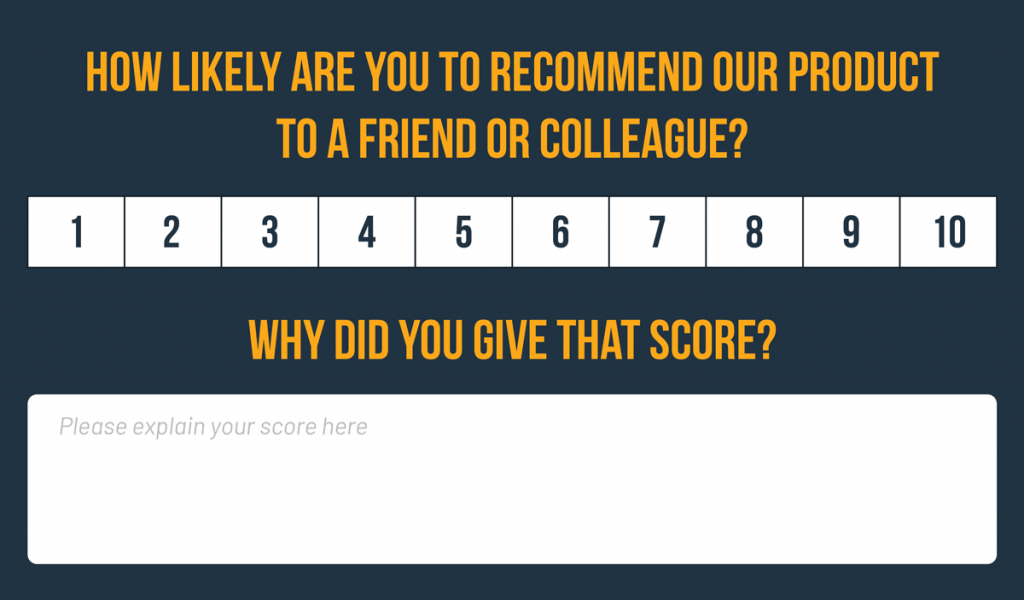
Respondents are then grouped as follows:
- Promoters (score 9-10): loyal fans who will keep buying and refer others to you and your online shop.
- Passives (score 7-8): satisfied customers, who like you but would also buy from a competitor if the offer was attractive enough.
- Detractors (score 0-6): unhappy customers who are unlikely to buy from you again and can hurt your brand through negative word of mouth.
Subtracting the percentage of detractors from the percentage of promoters results in the NPS.

The NPS value can range anywhere between -100 (everyone is a detractor) and a maximum of +100 (everyone is a promoter).
Once you have that information, you can start improving the CX for those who are passive or detractors.
💡BONUS TIP
Add an NPS survey to your post-purchase email flow and also add a field for respondents to leave a comment. That way, you get an updated NPS with every product you sell and insights into why someone gave their response.
2. Analyse the Tickets of Your Customer Support
Another great way to collect customer anecdotes is to take a look at the tickets of your customer support.
Specifically, you want to search for recurring patterns that cause these contacts in the first place.
For example, in my role as a vendor manager at Amazon, I once deep-dived into multiple customer complaints about chocolate products being sent to customers past their due date.
While this did not pose any harm or risk to the health of our customers, they clearly weren’t happy about it:

So I partnered up with our supply chain team and we came up with a process that ensures the product due date is at least a couple of months in the future when shipping chocolate to our customers.
And it didn’t take long until customers noticed:

Nice!
💡BONUS TIP
Ensure your support teams can raise issues directly to your business. They’re the first who know about products or processes that cause issues with your CX. That way, you can address the root cause before the problem begins to scale.
3. Conduct Surveys
At this point, you’ve already gathered a LOT of insights on how your customers think about their shopping experience with you.
Nice work.
But you might be thinking: “How can I ask my buyers some more specific questions?”
A good way to do this is through surveys.
But how?
First, make a list of all the questions you want to get insights on.

Then, define the criteria a customer needs to meet to become an eligible participant in your survey.

Lastly, invite prospects who fit your profile and analyse the results. You’ll be surprised how many consumers are willing to make their voice heard.
💡BONUS TIP
If you don’t know which survey tool to use, check out this article of the guys from Wordstream. They compared 8 online survey tools you can use to get started.
How to Improve Your Ecommerce Customer Experience: 5 Proven Strategies
As you know by now, CX has a HUGE impact on the buying decision of your customers.
Which means that you can increase your revenue with an optimised customer experience strategy.
And in this chapter you’ll learn exactly how to improve the CX of your ecommerce store.
- Focus on availability
- Don’t hide your contact details
- Create high-quality content
- Simplify your checkout process
- Bridge the gap between online and offline
- BONUS: Keep your shipping promise and ship fast
1. Focus on Availability
In my opinion, the availability of your products is the most important factor in ecommerce.
(Yes, even before content or the product itself)
True to the motto: You can’t sell what you don’t have in stock.
I’m sure you can relate to the feeling when seeing the following message:

It’s SUPER frustrating when you find a product you really want to buy, only to find out that it isn’t ready to order.
And your customers feel exactly the same.
We live in a world where consumers want their items right away. The faster the better.
That means that the longer they have to wait to receive their order, the lower will be your conversion rates.
And in ecommerce, the availability of your products is the starting point to a great CX.
💡BONUS TIP
If you run out of stock, ensure you give your customers the option to get notified when the item becomes available again. That way, you can reduce the number of lost sales.

2. Make it Easy to Find Your Contact Information
There’s no other way to say it: Your customers expect you to be there for them.
And I get it – the more you grow, the more you need to pay for a call centre or in-house customer service that takes care of the contacts per order.
And while a FAQ section might reduce the number of contacts quite a bit, your customers expect to speak to your support team when they need to.
So don’t hide your contact details.
Instead, make it super easy to find your service hotline and email address.
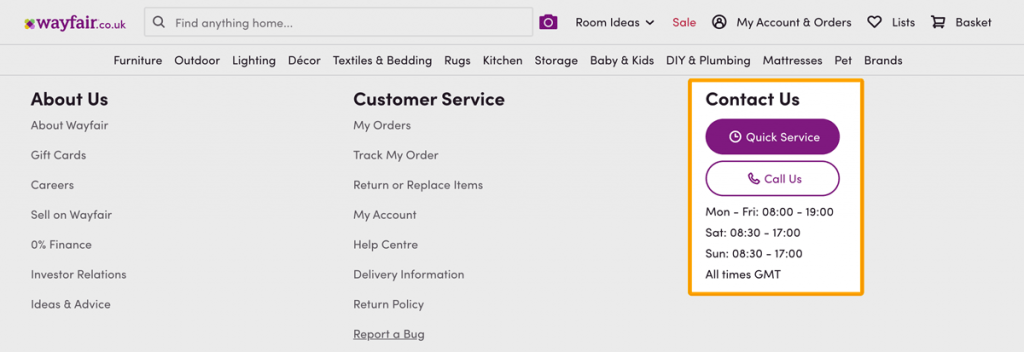
💡BONUS TIP
You can also include your contact details in emails, flyers, blog posts, social ads or your website’s FAQ section. That way, your customers can reach you whenever they come in contact with your brand.
3. Create High Quality Content
In ecommerce, your product page’s content is the equivalent to the ‘touch and feel’ experience your customers know and love from the high street.
That’s why marketplaces like Amazon or eBay use your content to identify the relevance of your product to a customer search query.
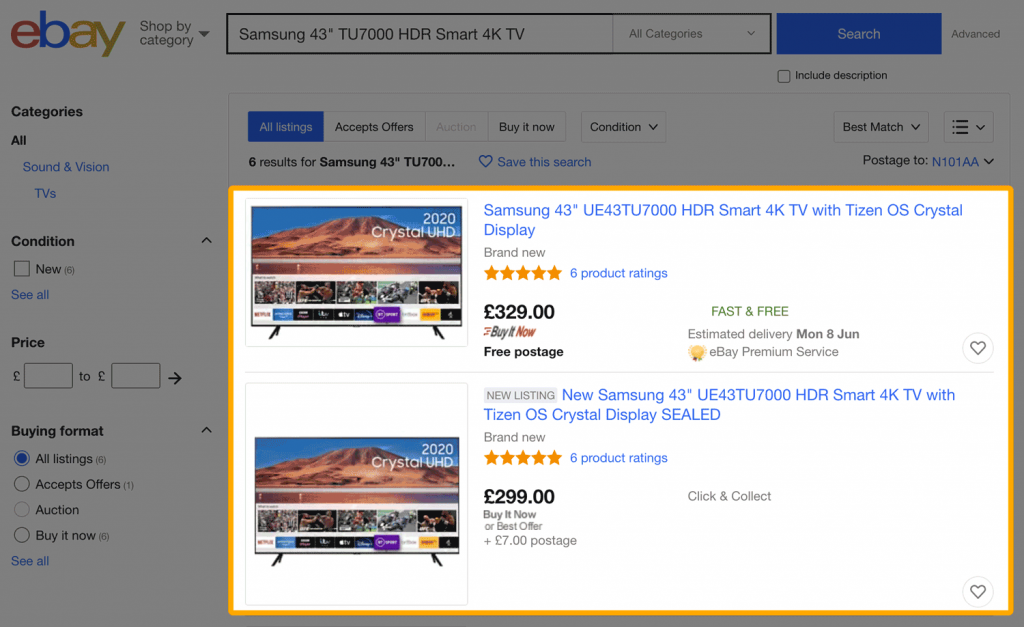
Also Google uses the content of your product page to rank it in their search results:
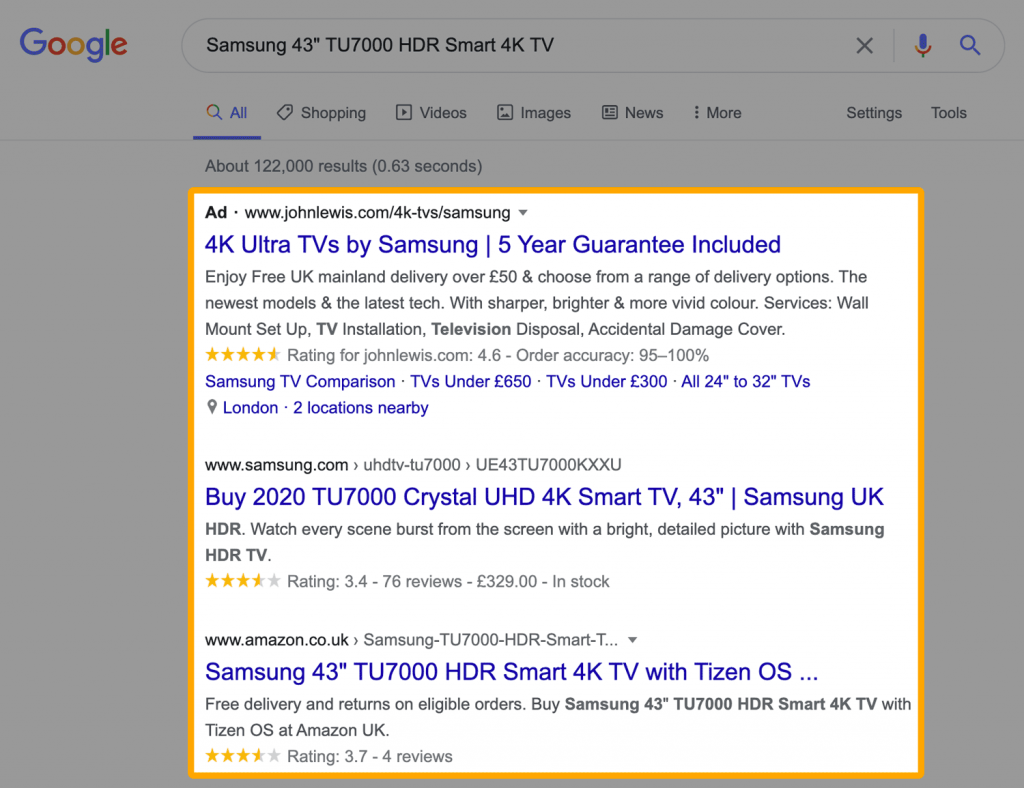
The bottom line? Your content needs to be super relevant to the search intent of a visitor to get featured in the top search results.
The question is:
How do you produce high quality content that optimises for marketplaces and Google alike?
Here’s my 5-step formula:
Step 1: Write a Compelling Title
Your product title draws customers from the search results onto your detail page.
And it is one of the most read sections of an online shop:

So your product headline needs to include the relevant information people are looking for.
A simple formula you can use is:
[Brand] + [Model no.] + [Model name] + [Brief description]
Which translates into:
Oral-B Pro 650 CrossAction Electric Rechargeable Toothbrush and Case
A common mistake I see is that many brands try to stuff keywords into the product title. Don’t do that!
Instead, keep your title short and sweet: 80 characters should be the absolute maximum.
💡BONUS TIP
Amazon provides a style guide for title formats for each of their product categories. You can use it to create a fully optimised title for your products in less than 3 minutes.
Step 2: Add a Unique Product Description
After optimising your title, it’s time to write your product description.
But instead of starting to write down a generic list of features nobody cares about, think about the main benefits your product offers to its users.
In other words: Let people know what problem your product solves.
The web shop of Dropbottle.com does this extremely well:

Step 3: Use High Quality Images
Whether you use digital renders or pictures taken in a photo studio.
Your product images need to be crisp and clean.
First, you should remove any noise in the background. Most shops use a simple white background.
Then, make your product the hero of your landing page. It should tell the visual story and appear multiple times from all relevant angles.
💡BONUS TIP
Display your product in action. That way, your visitors can see how it looks and works in real life.
If you take a look at the Nike online shop, you’ll see their hero products being pictured in lifestyle activities of their models. That’s an easy way to let their product speak for itself.

Step 4: Add Videos
If you want to take it one step further, add videos to your product pages.
Studies have shown that videos can increase conversion rates by up to 80% on ecommerce sites.
So yes, people love video.
And if you sell products that need a bit of explanation, you should use video to persuade iffy shoppers to click the buy button.

Step 5: Add Variations
Do you sell more than one variant of a product? Then display the different options on each detail page.
That way, you give users a way to quickly choose between colours or sizes, without having to return to the search bar to find a different version.
This can also help you to up-sell customers who are willing to pay more for additional features or benefits.
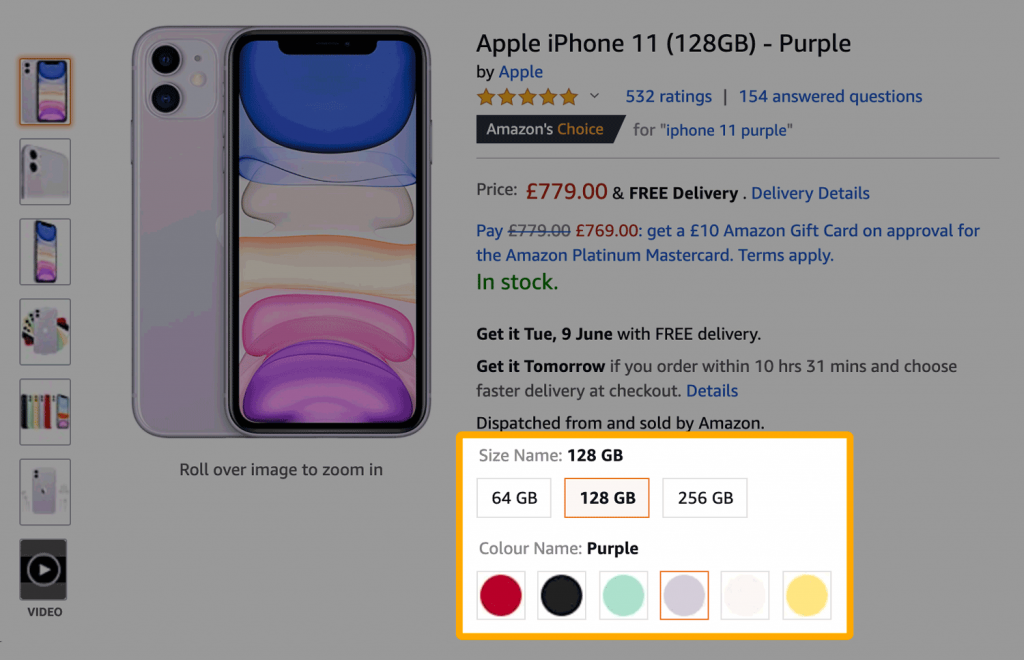
4. Simplify Your Checkout Process
This may be one of the most effective ways to boost your ecommerce customer experience (and conversions):
Make it super simple for users to buy your products.
Let me explain:
If you sell only one type of product, letting visitors confirm their cart before sending them to your checkout page will lose you a ton of sales.
Instead, you should redirect shoppers directly to your checkout page, once they clicked the buy button.
This simple change can reduce your cart abandonment rate by up to 76%.

But what if you have multiple products to sell?
Make sure your checkout process is as simple as possible:
First, reduce the number of forms users have to fill out.
Then, only ask for information you need to complete the transaction.
That’s all there is to it.
5. Bridge the Gap Between Online & Offline
Chances are that you didn’t buy your last pair of glasses or lipstick online.
Trying a pair of sunglasses in an offline store gives potential buyers the option to talk to an optician and to feel the quality of the material.
That’s hard to recreate in an online shop.
Yet, there are ways to bridge this gap. Many ecommerce stores use virtual try-on options to enhance their customer experience.
For example, Specsavers gives its users the choice to try on their entire collection by using a virtual assistant. It even recommends frames that match the facial shape of the end-user.

Not only is this a great way to reduce the number of customer returns. It also lets your users discover a wider range of your products.
So if you sell products that people like to try out – let them virtually try it on in your online shop.
6. (BONUS): Keep Your Shipping Promise and Ship Fast
Speed matters, especially in ecommerce.
According to a Dotcom Distribution survey, 47% of online shoppers would pay more for same-day delivery and 87% rate shipping speed as a key factor to buy from a brand again.
Which means that users expect you to deliver fast – and on time.
What happens when customers receive their items late can be seen in the below chart. In early 2020, Amazon sellers got flooded with negative reviews when they weren’t able to keep up with the demand and failed to deliver in time.
Within less than two months, negative seller reviews shot up by 165%.

Great Ecommerce Customer Experience Examples (2024)
Let’s take a look at examples of online shops with a focus on a great customer experience.
Example 1: Apple.com
It’s no secret that Apple has one of the most appealing online stores out there. If you take a look at their website, it’s full of high-quality images with bold but clear copy.
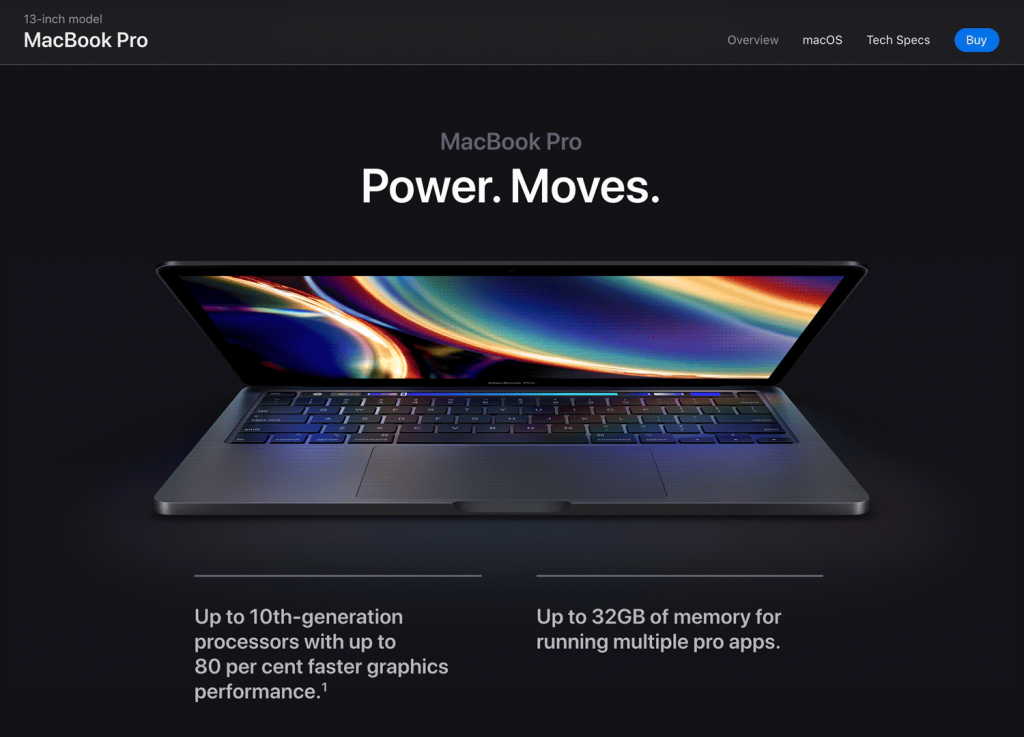
Apple’s products are the main heroes of any detail page you visit.
When choosing a device, interested buyers can explore the available models and variations.
And that’s exactly where they up-sell a large number of their customer base.
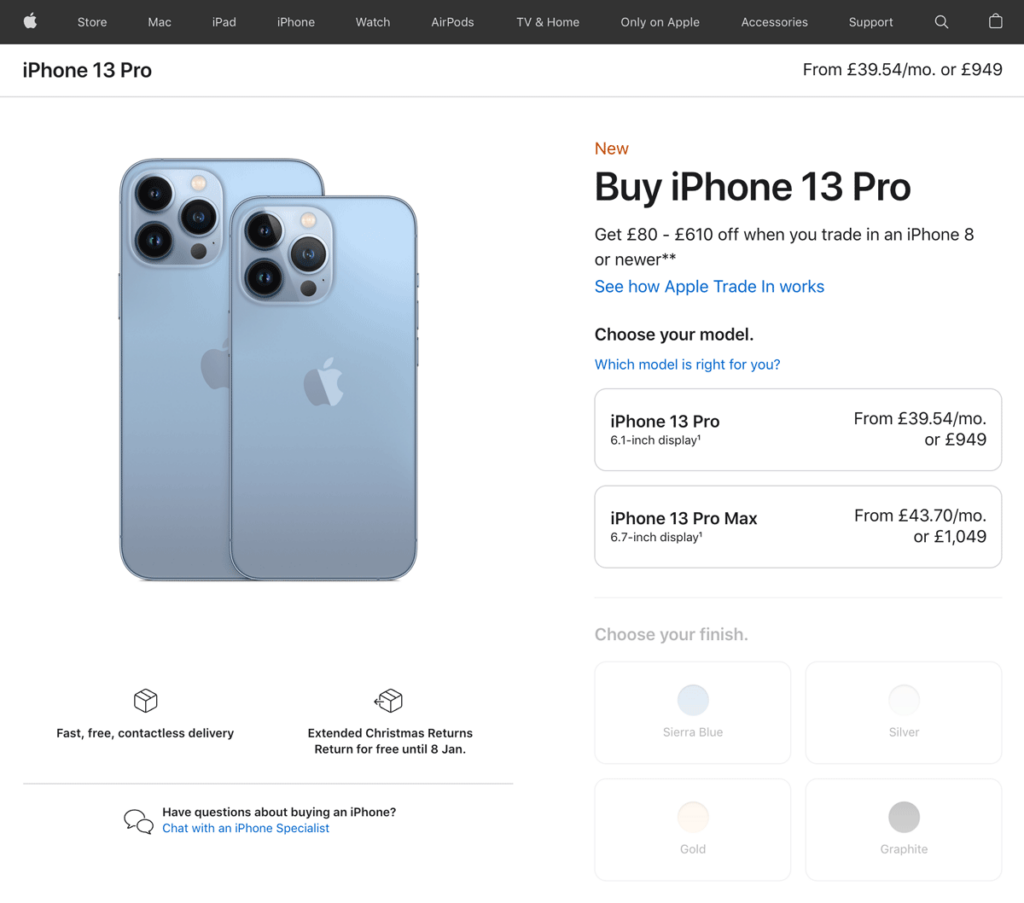
What can you learn from them?
- Let your product speak for itself.
- Use large, HQ images.
- Use renders that show your product from all angles.
- Explain how your product can support people in their life.
- Add text copy to support and explain what pictures can’t.
- Give users the choice to upgrade their cart.
Example 2: Farfetch.com
Another great ecommerce CX offers Portuguese fashion retailer Farfetch.
They use a simple and clean site design for their webshop. Plus, their imagery makes you want to book your next holidays right away.
(And of course their clothes)

Next to a minimalist design, their clean and focused site navigation makes it super easy for visitors to browse their store.
They also link to featured designers and collections that are in demand. This helps users to find brands and trending products in a snap.
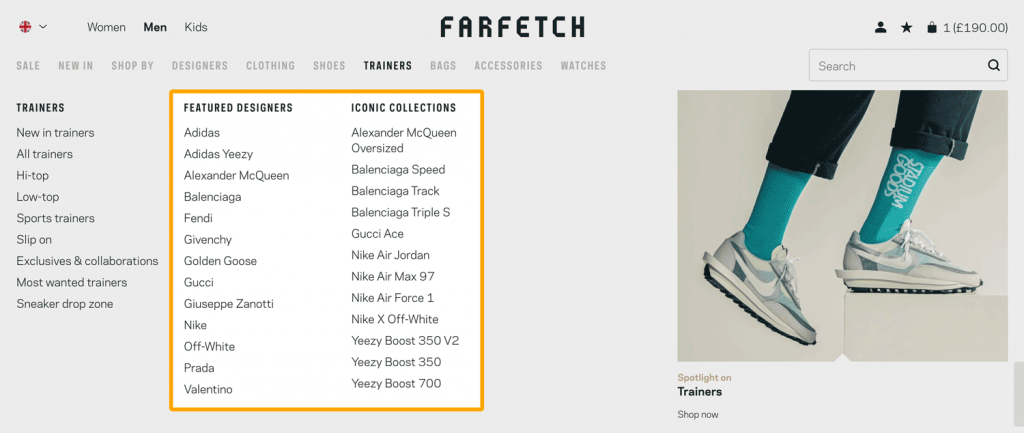
What can you learn from them?
- Link your products to positive emotions.
- Use images that show your products in action.
- Use a clear and simple site structure.
- Set up your site navigation with your customers in mind, i.e., list shortcuts to popular brands or trending products.
Conclusion
Obsessing about a great customer experience forms a vital aspect of your success in business. It builds loyalty and attracts new business. By focusing on providing a positive customer experience, you can differentiate yourself from your competition and also improve the overall satisfaction of your customers.
—
Enjoyed this article? Here are more things you might like:
7 Ecommerce Metrics to Measure From Today – Learn everything you need to know about metrics, KPIs and how to effectively measure them.
11 Easy Ways to Increase Your Conversion Rate – Learn how to turn more visitors into paying customers
Ecommerce Myths That Kill Your Business – A list of common ecommerce myths you should stop believing right now.

